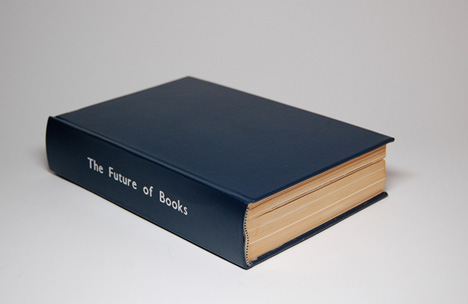by · Imprint

from Kyle Bean's "Future of Books," via Yanko Design
The first time we spoke was back in the pre-Kindle, pre-iPad days of 2006. For decades, you’ve actively been thinking about and working to augment the future of the book. What is your read of how the concept of the book has changed in the past five years?
There is the question of how it has involved in my mind and how it has evolved in the minds of the public. I view the book as a place where readers congregate and the social aspect of reading is where we’re going. The publishing industry is trying very hard to keep the traditional model of a book in tact, selling 300 or 400 pages to one reader at a time.
There is this social aspect: books are becoming these places to congregate, the form of expression is undergoing changes. In most cases e-readers and the e-book developers haven’t caught up to this. There are concepts that are too far afield, like people trying to write a novel collaboratively in World of Warcraft. I have no problem with such a book being considered fiction just like Tolkien but the execution isn’t there. And then there is something like Push Pop Press. Yes, the Al Gore book has interactive media but it is just for one reader at a time. They are simply books with audio and video on the page. We figured that out long, long ago. And it isn’t sustainable. When you’re doing something for the first time you can beg, borrow and steal all sorts of help when it comes to all this content. But when you go back to do it again and again you have to pay up.
My big problem with these apps is that they are like CD-ROMs, in the wrong sense – both are islands unto themselves. I’m reading The Waste Land all by myself. The apps are all walled in, all you have is the app. Heaven forbid you have an idea and want to go down the rabbit hole. You can, but you have to leave the app. I believe we are heading toward browser-based materials.
Read more: The Social Context of Reading: Five Questions for Bob Stein — Imprint-The Online Community for Graphic Designers
No comments:
Post a Comment